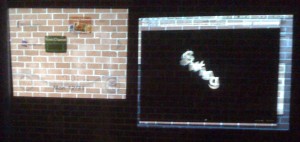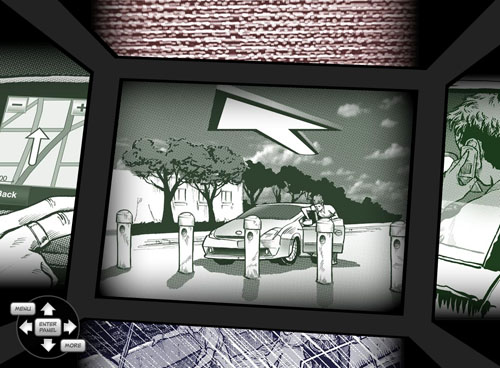Precision Targets launches; interactive comic and essay within a navigable cube
Animation, Announcements, Comics, Digital Humanities, Flash, Flex,
4/30/10
It’s been a long time in coming, but I’m very happy to announce the official launch of Precision Targets, a collaboration with scholar Caren Kaplan that uses a hybrid comic/essay format to explore the militarization of everyday life through technologies like GPS. Precision Targets places the user inside a cube containing six parallel stories told through interactive comic panels that are married to threads of commentary by Kaplan.
Precision Targets was my first collaboration with illustrator Ezra Claytan Daniels, and my first experiment with digital comics. Each story consists of four panels which can be browsed by rotating a cube. Individual panels (some of which contain animation and interactivity) can be entered and navigated with the mouse. Every panel has associated commentary by Kaplan which can be expanded by clicking “more”. Clicking “more” again further expands the commentary to a full-screen view for more in-depth reading, making it possible for users to switch between visual, textual, or hybrid reading modes at will. (Be sure to try adjusting the window size; the piece will adapt to whatever aspect ratio you like.)
One element of the project that can be easily missed is the Index, a force-directed SpringGraph visualization of the image and textual elements that make up the piece (you can access this feature by clicking “Menu” and then “Index”). You’ll see the individual graphic elements that make up each panel linked together in an interactive network diagram—to my knowledge, the first time a visualization like this has been applied to the individual layers of comic book panels (feel free to correct me if I’m in error).
This project was conceived before the current “motion comics” trend, so I’m very curious what people will think of the approach, which takes a different tack than most works labeled as such.
“Music, Lyrics and the Wii Remote: Creating ‘Swing’” this Wednesday at LA Flash
Announcements, Flash, Flex, LA Flash, Wii,
1/20/09
SoCal folk: come on out to 2009’s first meeting of LA Flash, this coming Wednesday, January 21st, from 7 - 10 pm—I’ll be giving a talk called “Music, Lyrics & the Wii Remote: Creating ‘Swing,’” followed by Amir Fischer covering “The Emerging market of 3D in Casual Gaming,” a raffle, and networking. I’m going to cover some background relating to the creation of “Swing,” and provide a brief introduction to WiiFlash, the ActionScript library that allows Flash to talk to the Wiimote, nunchuk, classic controller, and balance board. Would love to see you there!
Postmortem: “Swing” at LAFlashapaloozastock III
Events, Flash, Flex, Interactive Design, LA Flash, Music, Typography, Wii,
12/9/08

“Swing” was briefly installed outside next to a Wii running
Wii sports, but otherwise spent most of its time inside.
LAFlashapaloozastock III was another well put-together event—I enjoyed Ralph Hauwert’s talk on Flash effects and 3D as it was one of the best at bringing some perspective outside of the immediate world of Flash. Hauwert wove Escher, Pink Floyd, and the Amiga demoscene into the mix in a talk that otherwise would have just been a sequence of “ooh, cool!” demos (though they were quite cool… fluid dynamic bump maps on 3D objects, for instance…).
It was a challenge getting people comfortable enough with “Swing” to try it out—I had only one song request (“This Is How We Do It” by Montell Jordan) and that came early in the day, before a lot of folks started showing up. Over the course of the day I started calling the piece “karaoke for introverts” since no singing was required, but all the same people seemed reticent to pick a song and give it a go, just as if I had brought a real karaoke machine to the proceedings.
A student asked if I had considered adding greater variety to the visuals (color, etc.)—a valid question, given the apparent simplicity of the display. I explored this both during the original development of the piece and for this new version, but in both cases found that adding additional visual elements or processing made the experience too complex cognitively. While the YouTube video makes it look easy, trying to synchronize motions, syllables and pre-recorded music is actually a pretty challenging task for a novice, and glitz just makes it harder.
All in all, I came away with three keys to a successful “Swing” experience:
- You’ve got to feel comfortable
- You’ve got to love the song you’re performing and know it inside and out
- You’ve got to be tuned into the rhythmic implications of whether your text is broken down into words or syllables
All of these things are easier to realize at home than in an installation space, so I’m planning to post the new version of Swing (which will now run in a browser for both Mac and PC users) soon, probably after Ruben & Lullaby is released.
Speaking of which, I met a lot of great folks during the event and got a lot of interest in Ruben & Lullaby (my upcoming iPhone/iPod touch game). I’ll be putting the finishing touches on over the next week or so, so stay tuned…
Recent Posts
Go InSight: Composing a Musical Summation of Every Mission to Mars (Part 2)
Making music out of the data of interplanetary exploration.
Go InSight: Composing a musical summation of every mission to Mars (Part 1)
Making music out of the data of interplanetary exploration.
Cited Works from “Storytelling in the Age of Divided Screens”
Here’s a list of links to works cited in my recent talk “Storytelling in the Age of Divided Screens” at Gallaudet University.
Timeframing: The Art of Comics on Screens
I’m very happy to announce the launch of “Timeframing: The Art of Comics on Screens,” a new website that explores what comics have to teach us about creative communication in the age of screen media.
The prototype that led to Upgrade Soul
To celebrate the launch of Upgrade Soul, here’s a screen shot of an eleven year old prototype I made that sets artwork from Will Eisner’s “The Treasure of Avenue ‘C’” (a story from New York: The Big City) in two dynamically resizable panels.
Categories
Algorithms
Animation
Announcements
Authoring Tools
Comics
Digital Humanities
Electronic Literature
Events
Experiments
Exemplary Work
Flash
Flex
Fun
Games
Graphic Design
Interactive Design
iPhone
jQuery
LA Flash
Miscellaneous
Music
Opertoon
Remembrances
Source Code
Typography
User Experience
Viewfinder
Wii
Archives
July 2018
May 2018
February 2015
October 2014
October 2012
February 2012
January 2012
January 2011
April 2010
March 2010
October 2009
February 2009
January 2009
December 2008
September 2008
July 2008
June 2008
April 2008
March 2008
February 2008
January 2008
November 2007
October 2007
September 2007
August 2007
July 2007
June 2007
